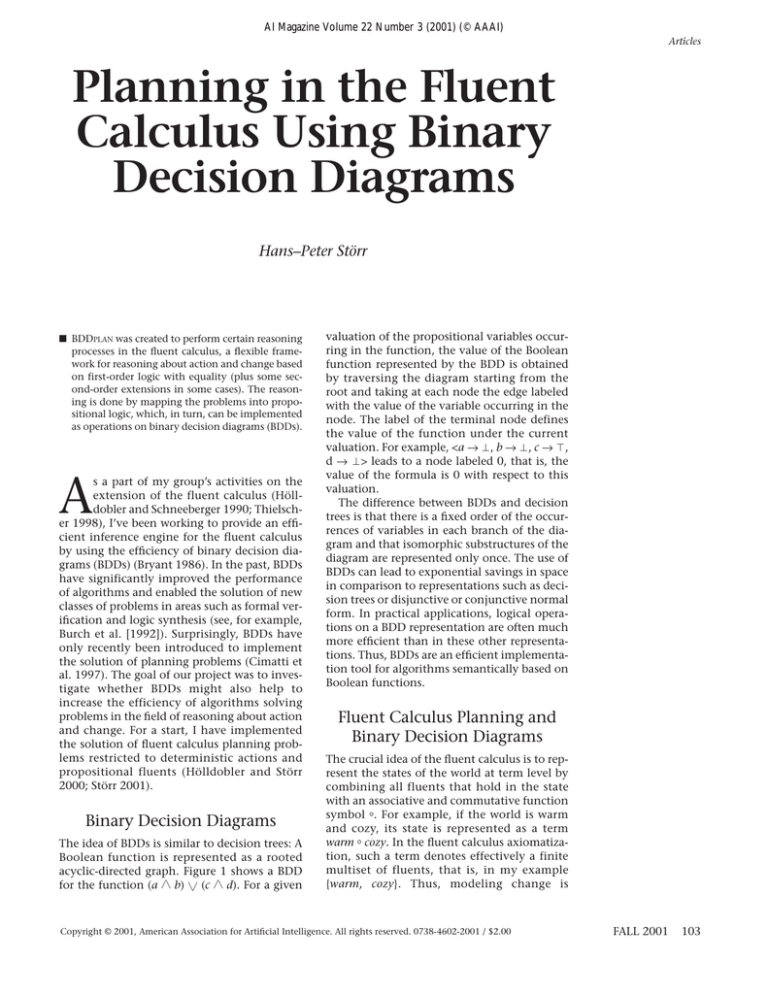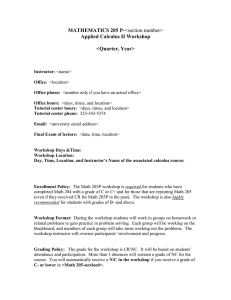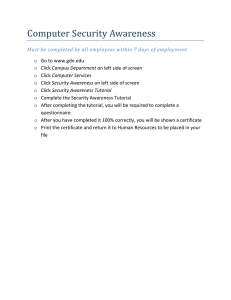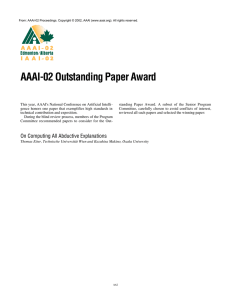
AI Magazine Volume 22 Number 3 (2001) (© AAAI)
Articles
Planning in the Fluent
Calculus Using Binary
Decision Diagrams
Hans–Peter Störr
■ BDDPLAN was created to perform certain reasoning
processes in the fluent calculus, a flexible framework for reasoning about action and change based
on first-order logic with equality (plus some second-order extensions in some cases). The reasoning is done by mapping the problems into propositional logic, which, in turn, can be implemented
as operations on binary decision diagrams (BDDs).
A
s a part of my group’s activities on the
extension of the fluent calculus (Hölldobler and Schneeberger 1990; Thielscher 1998), I’ve been working to provide an efficient inference engine for the fluent calculus
by using the efficiency of binary decision diagrams (BDDs) (Bryant 1986). In the past, BDDs
have significantly improved the performance
of algorithms and enabled the solution of new
classes of problems in areas such as formal verification and logic synthesis (see, for example,
Burch et al. [1992]). Surprisingly, BDDs have
only recently been introduced to implement
the solution of planning problems (Cimatti et
al. 1997). The goal of our project was to investigate whether BDDs might also help to
increase the efficiency of algorithms solving
problems in the field of reasoning about action
and change. For a start, I have implemented
the solution of fluent calculus planning problems restricted to deterministic actions and
propositional fluents (Hölldobler and Störr
2000; Störr 2001).
Binary Decision Diagrams
The idea of BDDs is similar to decision trees: A
Boolean function is represented as a rooted
acyclic-directed graph. Figure 1 shows a BDD
for the function (a b) (c d). For a given
valuation of the propositional variables occurring in the function, the value of the Boolean
function represented by the BDD is obtained
by traversing the diagram starting from the
root and taking at each node the edge labeled
with the value of the variable occurring in the
node. The label of the terminal node defines
the value of the function under the current
valuation. For example, <a → , b → , c → ,
d → > leads to a node labeled 0, that is, the
value of the formula is 0 with respect to this
valuation.
The difference between BDDs and decision
trees is that there is a fixed order of the occurrences of variables in each branch of the diagram and that isomorphic substructures of the
diagram are represented only once. The use of
BDDs can lead to exponential savings in space
in comparison to representations such as decision trees or disjunctive or conjunctive normal
form. In practical applications, logical operations on a BDD representation are often much
more efficient than in these other representations. Thus, BDDs are an efficient implementation tool for algorithms semantically based on
Boolean functions.
Fluent Calculus Planning and
Binary Decision Diagrams
The crucial idea of the fluent calculus is to represent the states of the world at term level by
combining all fluents that hold in the state
with an associative and commutative function
symbol . For example, if the world is warm
and cozy, its state is represented as a term
warm cozy. In the fluent calculus axiomatization, such a term denotes effectively a finite
multiset of fluents, that is, in my example
{warm, cozy}. Thus, modeling change is
Copyright © 2001, American Association for Artificial Intelligence. All rights reserved. 0738-4602-2001 / $2.00
FALL 2001
103
Articles
{zwarm → , zcozy → }
a
Thus, a set of terms can be represented by a
Boolean function that is true for a valuation iff
the corresponding term is in the set. For example, the set
b
{warm ° cozy, warm}
is represented by the Boolean function
(zwarm zcozy) (zwarm ¬zcozy),
c
d
The current
implementation as a
symbolic
breadth-first
search has the
advantage
that it always
finds the
shortest plan
and is able to
deal with
exponentially
long plans.
104
AI MAGAZINE
Figure 1. A Binary Decision Diagram for
(a b) (c d).
mapped to a rewriting of terms, which proves
to be a flexible axiomatization technique
(Thielscher 1998) and has computational
advantages.
A planning problem in the fluent calculus
amounts to a proof of a logical consequence:
∆ ç t = state(s)
(1)
where ∆ is a fluent calculus axiomatization of
the considered planning; t is a term representing a state that fulfills the goal of the problem;
s is a situation, that is (roughly), a term that
encodes an action sequence; and state(s)
denotes the state holding in a situation s. The
semantics of state is determined by ∆. Please
note that equation 1 declares that state t is
reachable in the planning problem because it
can be reached by the action sequence encoded
in s.
The process applied in my system is currently a straightforward breadth-first search over
the set of reachable states, which amounts to
generating all terms t occurring in consequences of the form (equation 1). The calculation process is stepwise: The sets of states
reachable from the initial state after execution
of n actions are consecutively generated.
The crucial point in my application of BDDs
is that one can represent sets of terms representing states as a BDD whose size is in many practical cases much smaller than the set itself. The
basic idea of this encoding is that each term can
be represented uniquely by a valuation of a set
of propositional variables, such that for each
fluent f the propositional variable zf is true iff f
occurs in the term. For example, the term warm
cozy is represented by a valuation
which can, in turn, be represented by a BDD.
The encoding is discussed in full detail in Hölldobler and Störr (2000).
It is well known that the manipulation of
sets given by their characteristic function can
be performed by logical operations on this
function. Thus, the manipulation of term sets
encoded by Boolean functions, as discussed,
can be implemented by BDD operations. Furthermore, I devised a BDD-based way to implement the rewriting of terms taking place in our
domain specification ∆ to describe actions.
Thus, I have been able to map the planning
process onto the manipulation of Boolean
functions in BDD representation. The algorithm is closely related to model-checking algorithms (Burch et al. 1992) that perform symbolic breadth-first search in the state space.
Implementation Remarks
To enable comparison of my planning algorithm, I developed a fluent calculus semantic
for the ADL fragment of PDDL (Störr 2001),
which is the base for my planner BDDPLAN. The
implementation was done in C++ using the
University of California at Berkeley CAL BDD
package.
An important factor for the efficiency of
BDD algorithms is the order in which the variables occur in the BDD because good variable
orderings can lead to exponentially smaller
BDDs. For our purposes, I developed an ordering principle called sort order that leads to good
results on many problems. We are still in the
process of investigating how optimization
techniques well known in the area of model
checking using BDDs can be adapted such that
they increase the efficiency of the implementation. Disjunctive partitioning of the transition
relation and frontier simplification have successfully been applied to date.
Discussion
I have started to investigate how reasoning
problems in the fluent calculus can be supported by a BDD reasoning engine. A general problem with BDD algorithms is their tendency to
Articles
AAAI-02 Intelligent Systems Demonstrations
The AAAI-02 Intelligent Systems Demonstrations program
showcases state-of-the-art AI implementations and provides AI researchers with an opportunity to show their
research in action. Implemented intelligent systems allow us
not only to experimentally validate AI research, but also to
make AI research accessible to each other, to the broader scientific community, and to the public at large.
Researchers from all areas of AI are encouraged to submit proposals to demonstrate their systems. Submissions
will be evaluated on the basis of their innovation, relevance,
scientific contribution, presentation, and “user friendliness,” as well as potential logistical constraints. This program is primarily to encourage the early exhibition of
research prototypes, but interesting mature systems and
commercial products are also eligible (commercial sales and
marketing activities are not appropriate in the Demonstration program, and should be arranged as part of the AAAI
Exhibit Program). Demonstrations that can be used by the
audience and/or that interact with the audience are particularly encouraged.
Demonstration systems should be available as much as
possible during the conference Exhibition. Each demonstration will have a scheduled and advertised time during which
it is the featured demonstration. All demonstrations will
also be available during the AI Festival, which concludes the
Exhibition. Each accepted demonstration system must be
attended by at least one knowledgeable representative
(preferably an architect of the system) who will be available
to answer in-depth technical questions at scheduled times. ■ A detailed description of hardware and software
Demonstration proposals must be made electronically
requirements. Demonstrators are encouraged to be flexusing the forms at www.cs.rochester.edu/research/aaai2002
ible in their requirements (possibly with different demos
/isd/
for different logistical situations). Please state what you
Researchers who cannot access the world-wide web
can bring yourself and what you absolutely must have
may contact the organizers to make alternative arrangeprovided. Generally speaking, we can provide generic
ments. In addition to contact information, proposals must
PCs with standard software such as web browsers, cominclude the following, all of which may be submitted via the
puter monitors, and peripherals such as TVs and VCRs.
web:
We will do our best to provide resources but nothing can
be guaranteed at this point beyond space and power.
■ A two-page description in AAAI paper format of the
technical content of the demo, including credits and ref- Demo proposals must be received in their entirety including
erences.
any supporting materials by Friday, February 22, 2002.
■ A 150-word summary of the demo in plain text. Please Authors will be notified of acceptance by March 18, 2002.
include title, demonstrators, and affiliation. This sum- We especially hope that authors of papers accepted for premary will be used to compile a program for the demon- sentation at the conference technical program will be able to
demonstrate their research in the Intelligent Systems
strations.
■ An informal videotape of the demo (in NTSC VHS for- Demonstration Program. To present a system demonstramat), or a demo storyboard of not more than six pages tion, however, the authors must still submit a proposal contotal, that describes how the demonstration will proceed forming to the above requirements by the Demonstration
(as opposed to the technical merits of the research being program deadline. Submitters who wish to demonstrate
demonstrated). This is the committee’s primary method intelligent mechanical systems that interact with the real
of evaluating your proposal. Please emphasize the ele- world (aka “robots”) should direct their efforts toward the
ments that make your demonstration exciting and inter- AAAI Robot Exhibition.
If you have any questions or comments about the Intelesting. Videotapes (three copies) should be mailed to the
address given on the web page: George Ferguson, ligent Systems Demonstration program, we encourage you
Department of Computer Science, University of to address them to the program organizer, George Ferguson
Rochester, Rochester NY 14627-0226 Telephone: (ferguson@cs. rochester.edu).
(716)275-5766
blow up: The size of BDDs can be exponential
in the number of propositional variables of the
encoded Boolean function, so they can get
unmanageable on more complex problems.
There are quite a number of techniques to alleviate this problem, but it is limiting the use of
BDDs. Still, we received promising results for
some planning problems. The current implementation as a symbolic breadth-first search
has the advantage that it always finds the
shortest plan and is able to deal with exponentially long plans (such as in the towers of Hanoi
problem).
Thus, it seems that BDDs are a valuable tool
to use in planning algorithms, but they have
their limitations. I envision the appropriate use
of BDDs in a toolbox of algorithms from
which, for each planning problem, the appropriate one can be chosen to solve the problem
or which can work concurrently on the problem until a solution is found.
References
Bryant, R. E. 1986. Graph-Based Algorithms for
Boolean Function Manipulation. IEEE Transactions
on Computers 8(C-35): 677–691.
Burch, J.; Clarke, E.; McMillan, K.; and Dill, D. 1992.
Symbolic Model Checking: 1020 States and Beyond.
Information and Computation 98(2): 142–170.
Cimatti, A.; Giunchiglia, E.; Giunchiglia, F.; and Traverso, P. 1997. Planning via Model Checking: A Decision Procedure for AR. In Proceedings of the Fourth
European Conference on Planning (ECP97), eds. S. Steel
and R. Alami, 130–142. Lecture Notes in Artificial
Intelligence 1348. New York: Springer-Verlag.
Hölldobler, S., and Schneeberger, J. 1990. A New
Deductive Approach to Planning. New Generation
Computing 8(3): 225–244.
Hölldobler, S., and Störr, H.-P. 2000. Solving the
Entailment Problem in the Fluent Calculus Using
Binary Decision Diagrams. In Proceedings of the First
International Conference on Computational Logic (CL),
eds. J. Lloyd, V. Dahl, U. Furbach, M. Kerber, K.-K.
Lau, C. Palamidessi, L. M. Pereira, Y. Sagiv, and P. J.
Stuckey, 747–760. Lecture Notes in Computer Science 1861. Berlin: Springer-Verlag.
Störr, H.-P. 2001. Planen mit binären Entscheidungsdiagrammen (Planning with Binary Decision Diagrams). Ph.D. dissertation, Department of Computer
Science, Dresden University of Technology. Forthcoming.
Thielscher, M. 1998. Introduction to the Fluent Calculus. Electronic Transactions on Artificial Intelligence
2(3–4): 179–192. Available at www.ep.liu.se/ea/cis/
1998/014/ .
Hans-Peter Störr is a research
assistant at Dresden University of
Technology investigating applications of AI in electronic commerce.
His current research interests
include binary decision diagrams,
nonmonotonic logic, machine
learning, fuzzy logic, and personalization issues. His e-mail address is
hans-peter@inf.tu-dresden.de.
FALL 2001 105
Articles
Call for Proposals
AAAI-02 Tutorial Forum
Eighteenth National Conference on Artificial Intelligence
July 28–August 1, Shaw Convention Center, Edmonton, Alberta, Canada
Sponsored by the American Association for Artificial Intelligence
The AAAI-02 Program Committee invites proposals for the Tutorial
Forum of the Eighteenth National Conference on Artificial Intelligence (AAAI-02). The Tutorial Forum will be held July 28-29, 2002 in
Edmonton, Alberta, Canada. Anyone interested in presenting a tutorial at AAAI-02 should submit a proposal to Michael Littman, 2002
Tutorial Chair, at the address below.
What Is the Tutorial Forum?
The Tutorial Forum provides an opportunity for junior and senior
researchers to spend two days each year freely exploring exciting
advances in disciplines outside their normal focus. We believe this
type of forum is essential for the cross fertilization, cohesiveness, and
vitality of the AI field. We all have a lot to learn from each other; the
Tutorial Forum promotes the continuing education of each member
of the AAAI. Once again this year, attendance at the tutorials will be
included in the AAAI-02 technical registration fee.
Topics
AAAI is interested in proposals for advanced tutorials at the leading
edge of AI. We especially encourage tutorials taught by a strong team
of two established researchers, providing a balanced perspective on a
core research topic. We are interested in tutorials that summarize
recent technical advances in active core areas of AI. We are also interested in tutorials that educate the AI community about emerging
opportunities, technologies and problem areas that are in their adolescence, such as intelligent real-time systems, education, AI and
entertainment, knowledge acquisition and information gathering on
the web, and particularly those topics we didn’t imagine to mention.
We are equally looking for tutorials about core methods from other
computational and scientific disciplines that promise a strong synergy
with AI methods, such as traditional computer science, operations
research, cognitive psychology, etc. We are very interested in exploring
innovative proposals for educational approaches that go beyond the
traditional format of four-hour tutorials, exploiting the flexibility that
a one-fee program offers.
AAAI-2000’s forum included tutorials on: probabilistic robotics;
practical tools for knowledge representation and nonmonotonic
reasoning; new frontiers in statistical natural language processing;
foundations of electronic market; approximation techniques for
automated reasoning; text mining; solving and programming with
soft constraints; vision-based interaction and control; recent
advances in AI planning; text summarization; empirical methods for
106
AI MAGAZINE
artificial intelligence and computer science; conceptual modeling
and ontological analysis; and user modeling and adaptive interfaces.
This list serves merely as an example. We are looking for continued
innovation in the forum’s program that incorporates novel and
under-represented topic areas.
Submission Requirements
We need two kinds of information in the proposals: information that
will be used for selecting proposals and information that will appear
in the tutorial description brochure. The proposal should provide sufficient information to evaluate the quality of the technical content
being taught, the quality of the educational material being used, and
the speakers’ skill at presenting this material. Each proposal should
include at least the following:
■ Goal of the tutorial: Who is the target audience? What will the audience walk away with? What makes the topic innovative?
■ Content: Detailed outline and list of additional materials, augmented with samples, such as past tutorial slides and survey articles,
whenever possible. Be as complete as possible.
■ Tutorial description: A short paragraph summarizing the tutorial
outline.
■ Prerequisite knowledge: What knowledge is assumed.
Please also submit the following information about the team of presenters: name, mailing address, phone number, e-mail address; background in the tutorial area, including a list of publications and/or presentations; any available examples of work in the area (ideally, a
published tutorial-level article or presentation materials on the subject); evidence of teaching experience (courses taught or references);
and evidence of scholarship in AI or computer science.
Submission Deadline
Proposals must be received by October 15, 2001. Decisions about the
tutorial program will be made by November 30, 2001. Speakers should
be prepared to submit completed course materials by May 24, 2002.
Please e-mail proposal material to the tutorial chair at the following address. Hard copy submissions will also be accepted:
Michael Littman
AT&T Labs Research
Shannon Laboratory, Room A275
180 Park Avenue
Florham Park, NJ 07932-0971
Telephone: (973) 360-8312
Fax: (973) 360-8970
E-mail: mlittman@research.att.com


![MA1311 (Advanced Calculus) Tutorial/Exercise sheet 6 [November 4 – 5, 2010]](http://s2.studylib.net/store/data/011008002_1-e7fefd070c13dde95eee91f3f3a90be4-300x300.png)




